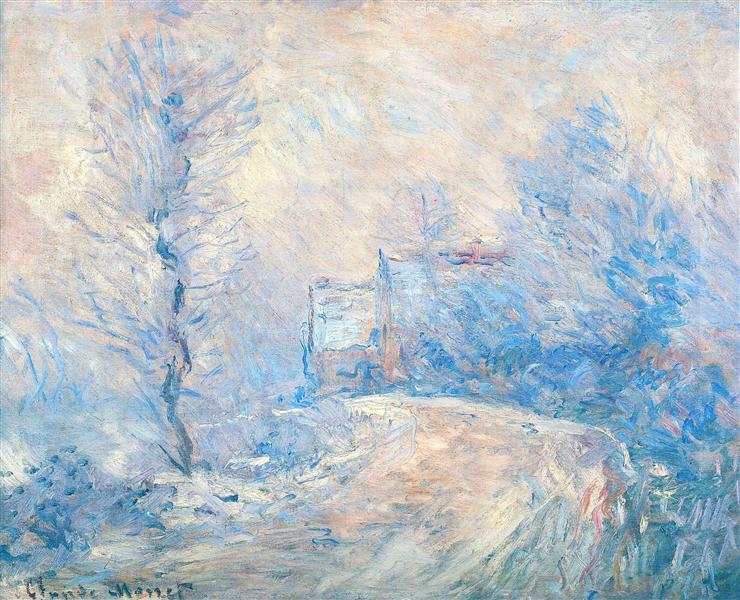Description
The painting "The entrance to Giverny under the snow" by Claude Monet, created in 1885, is a work that evokes the soft and contemplative atmosphere of a winter landscape, immersing ourselves in the delicacy of light and color that characterize the work of the work of the master impressionistic. Located in Giverny, his home and garden, the work represents access to his house, making it a central motive that not only captures a time in time, but also reflects the deep attachment of the artist to his surroundings.
The composition of the work is marked by the geometric simplicity of the elements: a soft hillside that leads to the threshold of the house, flanked by trees that seem to embrace the road. The scale seems almost reductive, as if Monet would like to invite the viewer to contemplate the intimacy and peace that a snow -covered landscape provides. The color palette, predominantly in cold tones of white, gray and touches of blue, shows the ephemeral luminosity that can arise in a snowy day. Whites vary in intensity, allowing the subtle nuances of the landscape to be perceived, giving a feeling of depth and texture in the white surface.
A remarkable aspect of this work is the way Monet captures the essence of light. The shadows in the snow are represented with loose brushstrokes that hint the trees and the road, creating an effect of movement and breathing in a landscape that, otherwise, could feel static. The fog dissipates subtly in the environment, allowing to glimpse the background, where the darkest tones reveal the proximity of the vegetation, almost like a reminder of life that persists in the coldness of winter.
Although the human figure is absent, the painting tells a history of loneliness and connection with nature. The stillness that radiates the work suggests a moment of reflection, an instant that the viewer is invited to stop and absorb the tranquility of the environment. Also, this absence of characters encourages the viewer to project their own experiences on the scene, turning the work into a mirror of their thoughts and emotions.
"The entrance to Giverny under the snow" also refers to an era when Monet was deeply influenced by the symbolism of the landscape, a constant in his career. The cold winter of the North of France and the serenity of Giverny become an ideal framework to capture the essence of impressionism, which seeks not only to capture visual aesthetics, but also evoke a sensory experience of the environment.
This work is placed in a broader context within the production of Monet, where the ephemeral of the moment becomes a central theme. Like other works of this era, Giverny's scenes show their interest in nature as a phenomenon that constantly changes, revealing through snow, a change in the perception of the landscape, capturing the sublime in everyday life.
In summary, "the entrance to Giverny under snow" is a work that mastery the calm and splendor of the winter landscape, encapsulating Claude Monet's artistic vision through its commitment to light, color and atmosphere. This painting not only stands as a testimony of the technique of impressionism, but also invites a deep reflection on our relationship with the environment, suggesting that, in the stillness of nature, we find a connection and a refuge.
KUADROS ©, a famous paint on your wall.
Hand-made oil painting reproductions, with the quality of professional artists and the distinctive seal of KUADROS ©.
Reproduction service paintings With a guarantee of satisfaction. If you are not completely satisfied with the replica of your painting, we refund your money 100%.

